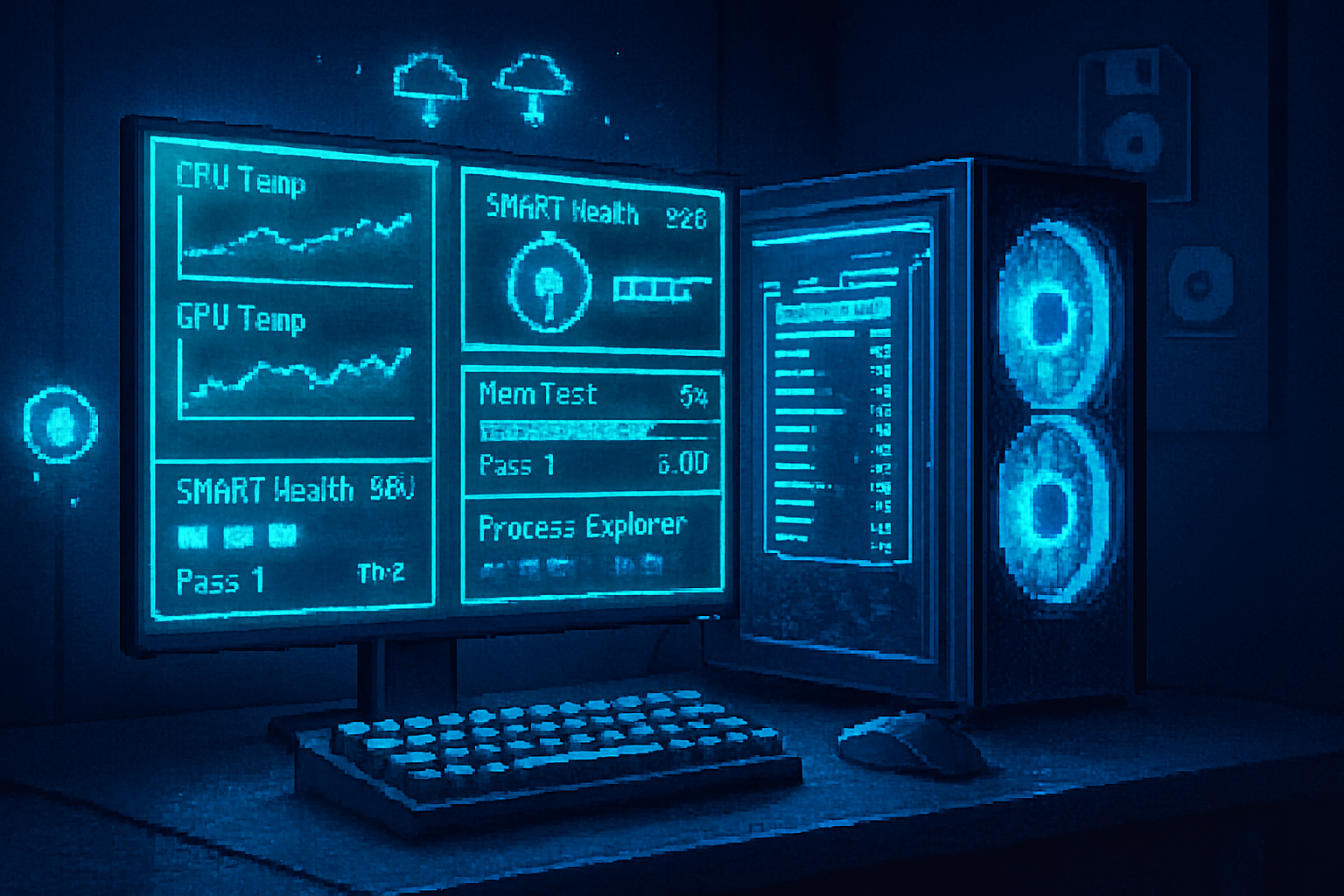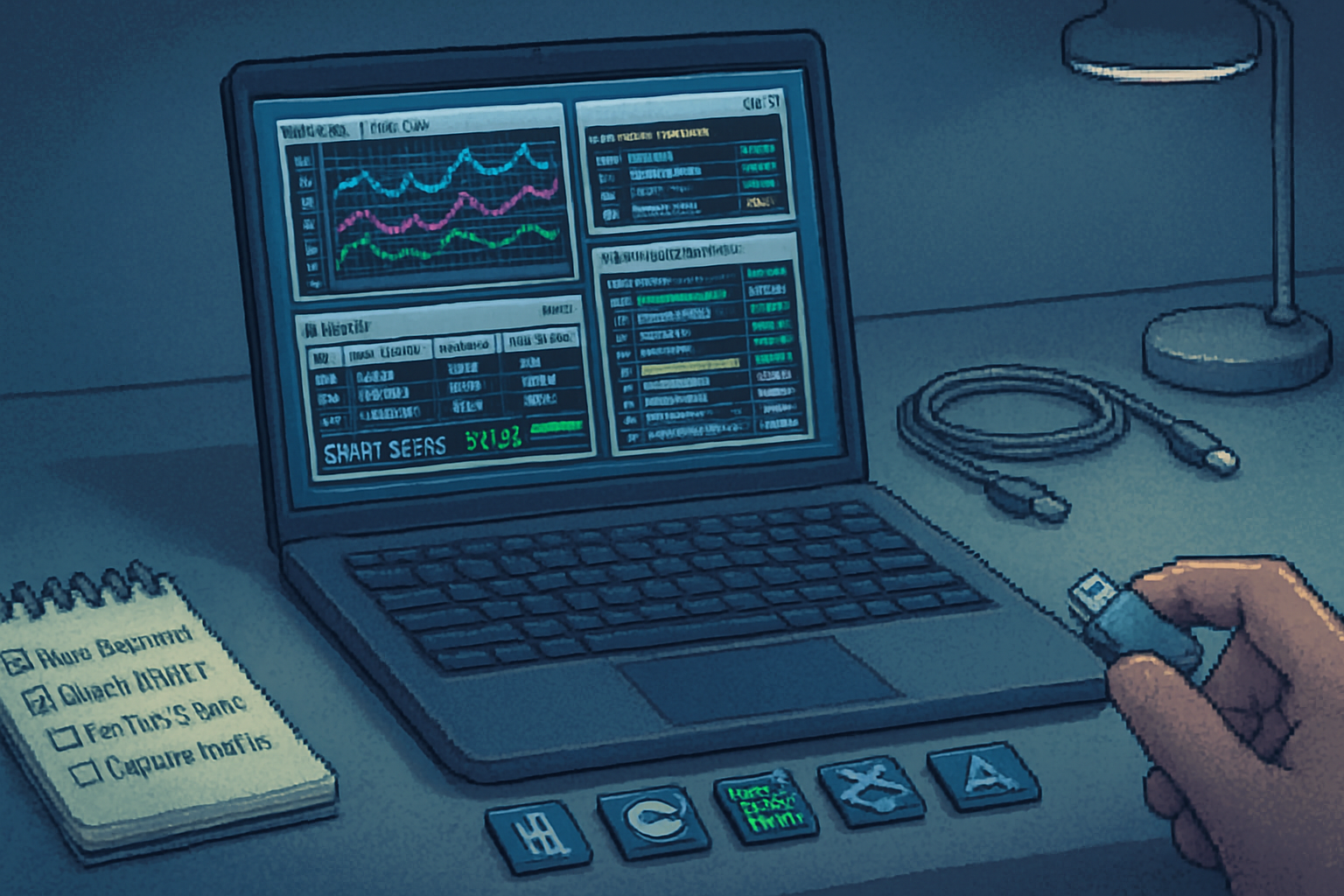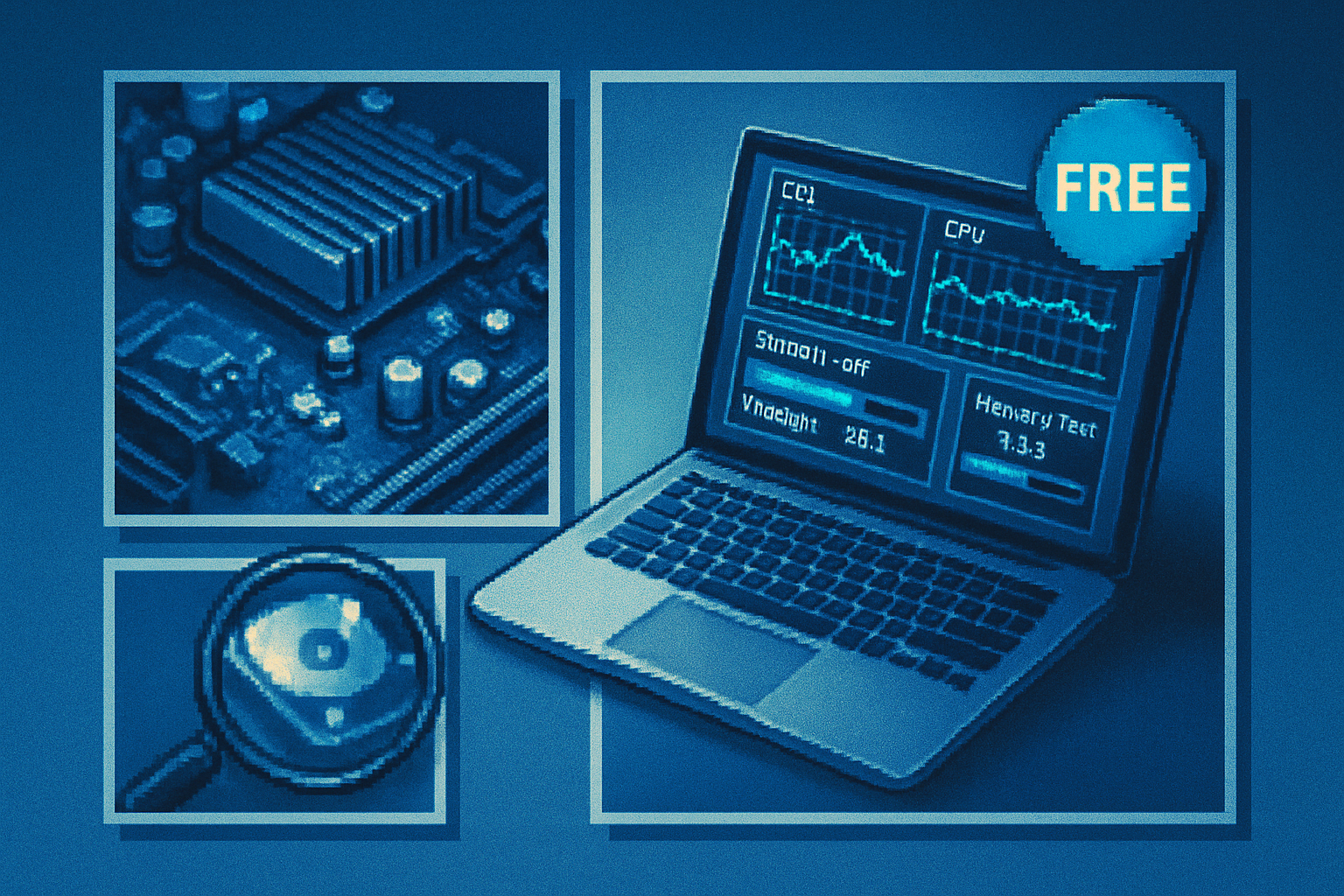· 7 min read
Do You Really Need Paid PC Diagnostic Tools? Debunking Myths with Free Solutions
A practical investigation into whether paid PC diagnostic suites are necessary. We debunk common myths, present free tools that cover most diagnostic needs, cite data (including Backblaze drive stats and AV test results), and walk through real-world case studies and step-by-step workflows.
Introduction
PC maintenance and troubleshooting have spawned an industry of paid diagnostic suites promising “one-click” fixes and deep system snapshots. That marketing raises a common question: do you really need to pay for diagnostics - or can free tools get you reliably to the same conclusions?
This article examines common myths, presents high-quality free tools and workflows, cites data and studies, and shares practical case studies that show when free solutions are enough - and when paid tools still make sense.
Common myths (and the reality)
Myth - “Paid tools find things free tools miss.” Reality: For the vast majority of consumer problems (malware, driver issues, failing drives, bad RAM, thermal throttling), free tools and built-in OS utilities provide the same diagnostic signals. Paid suites may package multiple checks and offer nicer UIs or support, but they rarely produce unique science-level results.
Myth - “Free antivirus/scanners are ineffective.” Reality: Modern built-in and free antivirus engines perform well in independent tests. For example, Microsoft Defender frequently ranks high in real-world detection in independent lab reports
Myth - “You need expensive hardware tools to test hardware.” Reality: SMART-based disk checks, memory stress tests, CPU/GPU stress tests, and thermal/voltage monitoring are all achievable with free software. Manufacturer tools can add detail, but free utilities uncover most issues.
High-quality free tools (quick reference)
Windows built-ins
- Task Manager, Resource Monitor, Reliability Monitor - troubleshooting performance and crashes. See Microsoft docs on viewing reliability history
- System File Checker (sfc) and DISM - repair system corruption. Docs:
- CHKDSK - filesystem/disk checks.
Hardware monitoring & info
- HWiNFO - live sensor data, extensive hardware reports: https://www.hwinfo.com/
- CPU-Z - CPU and memory details: https://www.cpuid.com/softwares/cpu-z.html
- Open Hardware Monitor - open-source sensor monitoring: https://openhardwaremonitor.org/
Disk health & benchmarks
- CrystalDiskInfo - S.M.A.R.T. readouts and health status: https://crystalmark.info/en/software/crystaldiskinfo/
- CrystalDiskMark - disk throughput benchmarks
- Manufacturer drive utilities (often free) for in-depth tests (Seagate SeaTools, Western Digital Data Lifeguard).
- Backblaze drive-failure data - their research shows how SMART attributes correlate with failure risk and helps validate SMART-based diagnosis
Memory and stability
- MemTest86 (free edition) - memory testing outside the OS: https://www.memtest86.com/
- Windows Memory Diagnostic (built into Windows)
CPU/GPU stress & stability
- Prime95 (torture tests), OCCT, FurMark (GPU stress): https://www.ocbase.com/, https://geeks3d.com/furmark/
Malware & second-opinion scanners
- Microsoft Defender (built into Windows) - competent real-time protection and recommended baseline.
- Malwarebytes Free - on-demand scanner for adware/PUPs/malware: https://www.malwarebytes.com/
Advanced tools
- Sysinternals Suite (Process Explorer, Autoruns) - deep process/autorun inspection. Docs:
- Wireshark for network packet capture: https://www.wireshark.org/
- iperf3 for network throughput tests: https://iperf.fr/
Data and research that support free diagnostics
Antivirus performance - Independent labs (e.g., AV-TEST) have repeatedly shown Microsoft Defender achieving detection rates comparable to paid products in many tests - making the built-in solution a solid baseline. See AV-TEST’s regular product evaluations:
Drive failure and SMART - Backblaze publishes multi-year datasets linking SMART attributes to failure rates and demonstrating that SMART-based tools reliably flag drives that later fail in the field. The Backblaze analysis is widely used as evidence that S.M.A.R.T. monitoring (via free tools like CrystalDiskInfo) is a meaningful first line of defense against drive failures:
Community & support - Many free tools are community-validated and widely used by support forums and technicians (e.g., Process Explorer, MemTest86, HWiNFO). Widespread adoption gives quick troubleshooting recipes and high confidence in findings.
Three practical case studies (realistic, replicable)
Case study 1 - Slow desktop after Windows update
Symptoms: Boot is slow; CPU at 90% intermittently; fan loud; system stutters.
Free-tool workflow used:
- Task Manager + Resource Monitor - identify processes consuming CPU.
- Process Explorer (Sysinternals) - inspect process tree and drivers.
- HWiNFO - view temperatures and clock throttling.
- Windows Reliability Monitor - check for event spikes.
- sfc /scannow and DISM - check and repair system files.
Outcome: Task Manager showed svchost.exe high CPU due to Windows Update stuck. HWiNFO showed CPU frequency dropping under load (thermal throttling) because dust-clogged cooler plus a failing fan. Cleaning the cooler and replacing the fan restored thermal headroom; DISM fixed a corrupted update component. All diagnostics used free tools and built-ins.
Case study 2 - Intermittent boot failure and disk errors
Symptoms: System sometimes fails to boot; file transfers show CRC errors.
Free-tool workflow used:
- CrystalDiskInfo - check SMART attributes (reallocated sectors, pending sectors).
- CHKDSK (from recovery environment) - surface + repair file system errors.
- Boot to a Linux live USB and ddrescue (free) to clone drive if needed.
Outcome: CrystalDiskInfo flagged increasing Current Pending Sector Count and reallocated sectors - strong indicators of a failing HDD (consistent with Backblaze SMART analysis). CHKDSK could temporarily fix filesystem inconsistencies, but SMART metrics proved the drive itself was deteriorating - the recommended action was drive replacement and restore from backup. Free tools gave a clear, actionable diagnosis.
Case study 3 - Random blue screens (BSOD)
Symptoms: Random BSODs with varied stop codes.
Free-tool workflow used:
- Reliability Monitor to see timeline of crashes.
- Dump analysis with the free WinDbg (from Windows SDK) or use WhoCrashed (free basic version) to parse crash dumps.
- MemTest86 - run overnight memory test.
- Prime95/OCCT - stress-test CPU and power delivery.
Outcome: Dump analysis showed a memory-related driver; MemTest86 returned multiple errors - bad RAM stick identified. Replacing the DIMM solved the BSOD problem.
When paid tools are still useful
Free tools answer most consumer and many power-user diagnostics. Paid tools make sense when:
- You need enterprise-class remote diagnostics, centralized reporting, or SLA-backed support.
- You require manufacturer-specific proprietary tests tied to warranty (some vendors provide OEM-only diagnostics for RMA triage).
- You want an integrated single-pane solution with automation, history, and professional-level reporting for an IT fleet.
Examples: A managed service provider or corporate IT team will benefit from paid endpoint management/diagnostic suites (remote diagnostics, asset inventory, automated remediation) even though the underlying tests could be run with free tools.
Practical step-by-step diagnostic checklists
If your PC is slow:
- Task Manager → sort by CPU/Disk/Memory to find top consumers.
- Run Malwarebytes Free (on-demand) and full Defender scan.
- Check disk health in CrystalDiskInfo.
- Run Resource Monitor for disk/memory wait chains.
- Check temperatures and throttling with HWiNFO.
If your PC crashes/BSODs:
- Open Reliability Monitor to view crash times.
- Collect and analyze minidumps with WinDbg or WhoCrashed.
- Run MemTest86 to test RAM.
- Run a CPU/GPU stress test (Prime95, OCCT) to reproduce instability.
If drives show I/O errors:
- Check SMART with CrystalDiskInfo.
- Backup immediately (dd, robocopy, or built-in backup tools).
- Run CHKDSK from recovery if needed.
- Replace drive if SMART shows increasing reallocated/pending sectors (Backblaze data supports SMART as a meaningful predictor of failure).
Tips to get paid-level value from free tools
- Combine tools - a single free utility rarely tells the whole story. Use HWiNFO + CrystalDiskInfo + MemTest86 + Process Explorer together for a multi-angle diagnosis.
- Run tests outside the OS where possible (MemTest86 from USB, offline disk cloning), to eliminate software interference.
- Document findings (screenshots, sensor logs) - that’s what paid management suites automate, but it’s easy to mimic manually.
- Keep a known-good bootable USB with your favorite free tools (Hiren’s BootCD, or custom WinPE / Linux toolkit).
Limitations of free solutions
- Convenience and polish - paid tools often wrap multiple checks into a nicer UI and one-click automation.
- Enterprise scaling and support - free tools usually lack centralized dashboards, commercial support, and audited SLAs.
- Proprietary hardware tests - some vendor-specific diagnostics or warranty-only tests may require OEM tools.
Conclusion
For most home users and even many power users, free diagnostic tools and built-in OS utilities are fully capable of identifying and resolving common problems: malware, failing drives, bad RAM, overheating, driver issues, and software corruption. Independent research (AV lab reports, Backblaze drive data) shows that free/built-in solutions and SMART-based monitoring are meaningful and effective.
Paid diagnostic suites bring convenience, integration, and support - features that matter for businesses, fleet management, and technicians who need time-savings and accountability. But before you pay, try the free toolbox: you may well find the answer (and the fix) without spending a dime.
Selected references
- AV-TEST - independent antivirus product evaluations: https://www.av-test.org/en/antivirus/home-windows/
- Backblaze - hard drive statistics, SMART analysis and failure reports: https://www.backblaze.com/blog/
- CrystalDiskInfo - S.M.A.R.T. drive monitoring tool: https://crystalmark.info/en/software/crystaldiskinfo/
- HWiNFO - hardware information and sensor monitoring: https://www.hwinfo.com/
- Sysinternals Suite - Process Explorer, Autoruns, and more: https://docs.microsoft.com/en-us/sysinternals/
- MemTest86 - memory testing utility: https://www.memtest86.com/
- Windows SFC/DISM guidance: https://learn.microsoft.com/en-us/windows/client-management/troubleshoot-system-file-corruption-using-sfc


